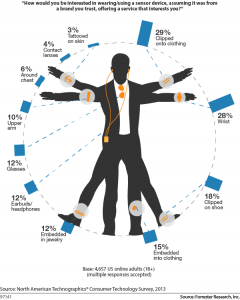 Wearable computing has received growing attention in the media, market and scientific research in the past decades. There are new devices available each day and they provide a lot of new opportunities for applications. Available in many different form factors, wearable devices aid to support not only gaming, fitness and fashion, but also safety critical and medical emergencies.
Wearable computing has received growing attention in the media, market and scientific research in the past decades. There are new devices available each day and they provide a lot of new opportunities for applications. Available in many different form factors, wearable devices aid to support not only gaming, fitness and fashion, but also safety critical and medical emergencies.
Glasses help to quickly access information, document life events through photos and videos, receive notifications and alerts, etc. Intelligent armbands aid to keep track of activities, including: eating and sleeping habits, and physical exercises.
Although wearable devices provide a lot of new opportunities, they are not (yet) widespread. Users may be concerned about privacy issues, or do not see clear benefits of these devices, perhaps their costs are still too high.
Better understanding what users (or potential users) think about wearable computing, can help to improve the design of these devices, and consequently to meet users’ expectations.



